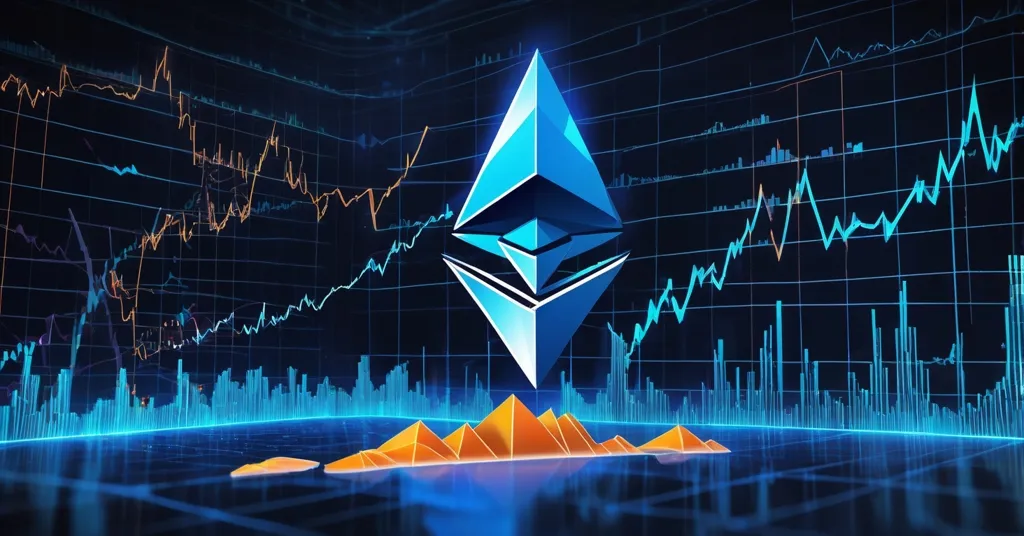Ether ETFs Hit $17B Weekly Volume, Outshine Bitcoin Inflows in 2024 Surge

Ether ETFs Smash Records with $17B Weekly Volume, Outpacing Bitcoin Inflows in 2024
Get ready for a market shake-up—Ether ETFs have just obliterated expectations, clocking a staggering $17 billion in weekly trading volume and outpacing Bitcoin ETFs in net inflows for five consecutive days. This isn’t just a blip; it’s a bold signal that Ethereum is stepping out of Bitcoin’s shadow, catching the eye of institutional players and rewriting the crypto investment playbook.
- Historic Volumes: US spot Bitcoin and Ether ETFs hit a combined $40 billion weekly trading volume, with Ether ETFs alone at $17 billion.
- Inflow Edge: Ether ETFs raked in $3.37 billion compared to Bitcoin’s $964.8 million from August 8-14.
- Institutional Power: Firms like Bitmine and Sharplink are hoarding Ether, showcasing corporate belief in Ethereum’s future.
Ether ETFs Break All Records: The Raw Numbers
The crypto ETF market in the US has just witnessed a historic week, with spot Bitcoin and Ether exchange-traded funds (ETFs) racking up a mind-blowing $40 billion in trading volume. For those new to the game, ETFs are financial products traded on traditional stock exchanges that track the price of underlying assets like Bitcoin or Ether, offering investors exposure without the hassle of directly owning crypto. While Bitcoin ETFs have long been the big dogs with $152.67 billion in assets under management (AUM)—a figure rivaling the market cap of major corporations like Nike—Ether ETFs have roared into the spotlight with $17 billion of that weekly volume, smashing their prior high of just over $10 billion from July 2024. Bloomberg ETF analyst Eric Balchunas summed up the frenzy perfectly:
“Spot Bitcoin + Ether ETFs did about $40b in volume this week, biggest week ever for them. Massive number, equiv to a Top 5 ETF or Top 10 stock’s volume.”
Balchunas didn’t stop there, coining the term “ETHSANITY” to describe Ether ETFs waking from a long slumber and packing a year’s worth of action into a mere six weeks, as noted in his recent commentary. But it’s not just about volume—Ether ETFs pulled in $3.37 billion in net inflows between August 8 and August 14, dwarfing Bitcoin ETFs’ $964.8 million over the same stretch. That’s five straight days of Ether outmuscling Bitcoin in fresh capital, a streak that’s got the market buzzing. Nate Geraci, president of NovaDius Wealth Management, threw some well-deserved shade at the skeptics:
“Spot ETH ETFs absolutely obliterated previous weekly trading volume records… wonder if there are any ‘no demand’ naysayers still out there.”
Why Institutions Are Piling Into Ethereum
So, what’s behind this sudden Ether mania? A huge driver is institutional investors finally recognizing Ethereum’s unique value beyond Bitcoin’s “digital gold” story. For the uninitiated, Ethereum isn’t just a cryptocurrency (Ether, or ETH); it’s a decentralized platform enabling smart contracts—self-executing agreements coded on the blockchain—and decentralized applications (dApps), which power everything from lending platforms to NFT marketplaces. Ethereum dominates the decentralized finance (DeFi) space with a total value locked (TVL, meaning assets staked in these protocols) of $86 billion, grabbing a 61% market share, while daily transactions have surged 73% year-over-year to 1.62 million, according to data from Nansen and DefiLlama. That’s the kind of utility that makes Wall Street take notice, as explored in discussions about Ethereum’s role in DeFi and smart contracts.
Big players are jumping in with both feet. Bitmine holds 1.29 million ETH worth $5.75 billion, recently snapping up 106,485 ETH ($470 million) in just 10 hours, while Sharplink isn’t far behind with 728,000 ETH valued at $3.3 billion, reflecting a trend of significant corporate investment in Ether. Corporate treasuries now own 1.93% of Ether’s circulating supply, a trend that’s only growing. This isn’t just speculative gambling—it’s a calculated bet on Ethereum as a backbone for future financial systems. And honestly, after years of Bitcoin hogging the limelight, who can blame Ether for muscling into institutional portfolios?
Price Swings and Market Hype: The Double-Edged Sword
Price action has fanned the flames too. Bitcoin recently hit a new all-time high above $124,000, while Ether neared its own peak at $4,878 before both pulled back over 5% and 6%, landing at $117,000 and $4,395 respectively as of recent market data. These rallies likely stoked ETF interest, but the quick corrections are a stark reminder that crypto volatility is alive and kicking. Ether’s implied volatility—a measure of expected price swings based on options trading—has spiked from 56% to 70%, per Deribit data, hinting at more rollercoaster rides ahead, as discussed in analyses of Ether’s trading trends.
Ethereum’s on-chain metrics add another layer of intrigue. Exchange balances for ETH have dropped to 15.6 million, the lowest since before the 2017 bull run, according to Glassnode. Less Ether sitting on exchanges means a potential supply crunch, which could push prices higher if demand holds strong. Post-Shanghai upgrade—a major 2023 update that made staking (locking up ETH to secure the network) more accessible—staking activity has surged, further tightening available supply. As one analyst on X, Defipeniel, called it, this mix of shrinking supply, ETF demand, and network growth creates a “cocktail of bullish energy.”
Yet, not everyone’s popping champagne. Analysts like Valentin Fournier from BRN have warned of potential sell pressure following the ETF launch hype, suggesting short-term dips before any sustained rally. And while long-term forecasts like Standard Chartered’s prediction of ETH hitting $7,500 by 2025 or even $25,000 by 2028 sound tantalizing, let’s be blunt: price predictions in crypto are often little more than wishful dart-throwing. We’re not here to peddle fantasies—take such numbers with a dump truck of salt.
Bitcoin Still Rules, But Ether’s Rising Fast
Don’t get it twisted—Bitcoin isn’t exactly quaking in its boots. Its ETFs still command a towering $152.67 billion in AUM compared to Ether’s $25.68 billion, a gap that cements Bitcoin’s status as the flagship crypto. As a Bitcoin maximalist at heart, I see BTC as the ultimate decentralized store of value, a hedge against inflation and government overreach that Ethereum doesn’t aim to replicate. Bitcoin’s narrative resonates especially in turbulent times, and its market presence remains unmatched.
But Ether’s ETF surge points to a maturing landscape where diversification is the name of the game. Institutions aren’t putting all their chips on one crypto anymore—they’re betting on Ethereum’s utility in powering DeFi giants like Uniswap (a decentralized exchange) and Aave (a lending protocol), which drive billions in economic activity, a trend unpacked in analyses of institutional impact on Ether ETFs. This isn’t a threat to Bitcoin; it’s a complementary force in our fight for decentralization. Both can disrupt the centralized finance status quo in their own badass way.
The Dark Side: Volatility, Regulation, and Hype Risks
Before we get too starry-eyed, let’s talk risks. Crypto remains the Wild West, and Ether’s ETF boom doesn’t change that. Regulatory clouds are always on the horizon—debates over whether staking counts as a security or if DeFi protocols face SEC crackdowns could spook markets. Look at the years of delays before Bitcoin ETFs got the green light; Ether’s journey is far from over. Plus, the hype around ETF inflows can fuel over-leveraged euphoria, setting the stage for brutal corrections. For every moonshot, there’s a potential rug pull waiting to slap the naive upside the head.
Historical parallels don’t lie—post-launch sell-offs have hit other crypto ETFs, and Ether’s not immune. The jump in implied volatility screams caution, and if institutional whales decide to cash out after riding the wave, retail investors could be left holding the bag. Corporate confidence from Bitmine and Sharplink is encouraging, but it’s no guarantee against market whims. This space doesn’t forgive blind optimism, a sentiment echoed in community discussions about why institutions are drawn to Ethereum.
What This Means for the Future of Crypto ETFs
The rise of Ether ETFs, cemented by their US launch in July 2024, marks a pivotal moment for crypto’s mainstream acceptance. It’s not just about numbers—it’s about traditional finance finally giving crypto a seat at the table. But this is also a battleground. Will Ether’s momentum spark a wave of altcoin ETFs for chains like Solana or Cardano? Or is this a fleeting pump destined to fizzle? One thing’s clear: institutional interest is accelerating adoption faster than ever, aligning with our push for effective accelerationism in disrupting outdated systems.
As we champion freedom, privacy, and decentralization here at Let’s Talk, Bitcoin, I’ll always root for Bitcoin as the bedrock of this revolution. Yet Ethereum’s niche—powering the smart contract economy—is one Bitcoin shouldn’t and doesn’t need to fill. This isn’t a zero-sum game. If big money keeps flowing in, we might just see the rapid shift to a decentralized future we’ve been fighting for. Just don’t get high on the hype—stay sharp, because this market bites back.
Key Questions and Takeaways for Crypto Enthusiasts
- What’s fueling the $40 billion crypto ETF trading volume?
A massive $17 billion surge in Ether ETF activity paired with strong Bitcoin ETF trading, driven by institutional appetite and bullish price moves for both assets. - Why are Ether ETFs beating Bitcoin in inflows?
With $3.37 billion versus Bitcoin’s $964.8 million over five days, Ether’s appeal lies in institutional diversification into Ethereum’s smart contract and DeFi potential. - Is Ether challenging Bitcoin’s dominance?
Not yet—Ether’s ETF inflows shine, but Bitcoin’s $152.67 billion AUM towers over Ether’s $25.68 billion, keeping BTC firmly on top. - How does institutional buying affect Ethereum’s outlook?
Holdings by firms like Bitmine and Sharplink, worth billions in ETH, signal corporate faith, potentially steadying demand despite market swings. - Should we expect volatility despite the ETF boom?
Hell yes—Ether’s implied volatility jump to 70% and analyst cautions about sell pressure mean short-term drops could hit even amid bullish signals. - Are Ether ETFs a sign of Ethereum’s maturity or just hype?
It’s a mix—strong network activity and institutional backing suggest maturity, but regulatory risks and volatile markets warn against calling it a done deal.



